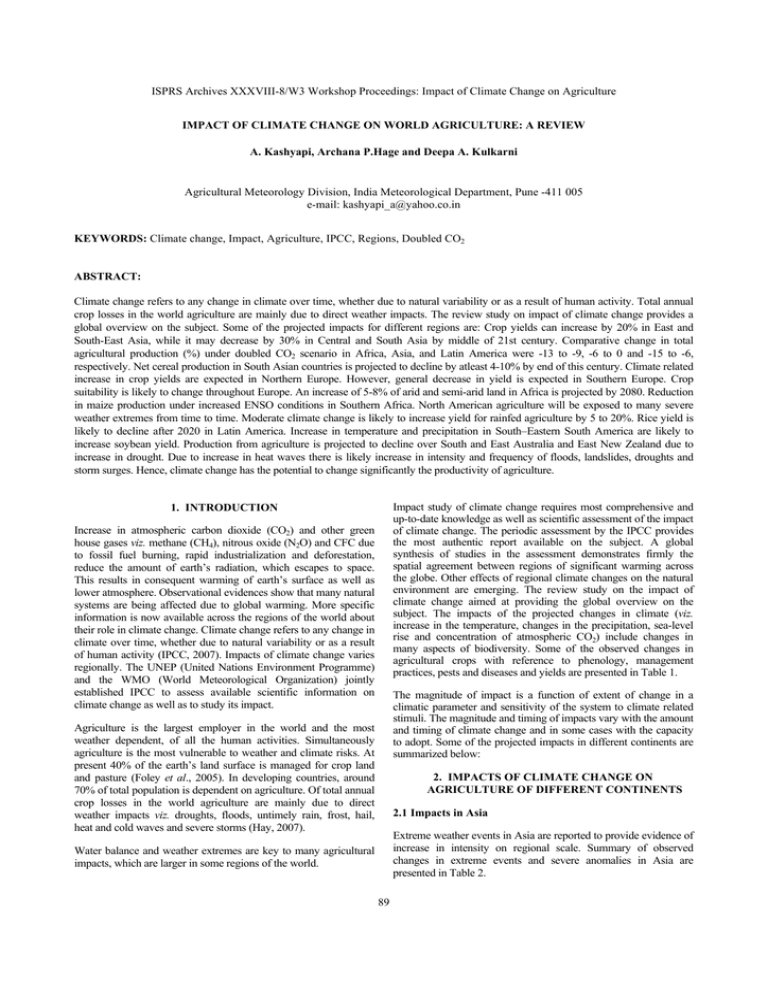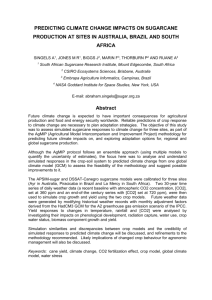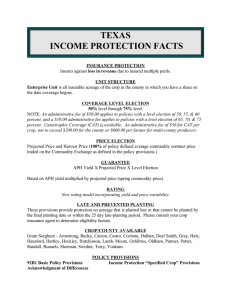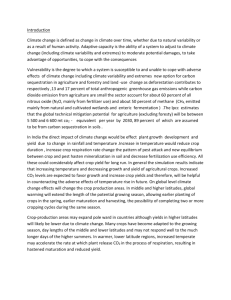ISPRS Archives XXXVIII-8/W3 Workshop Proceedings: Impact of Climate Change on... IMPACT OF CLIMATE CHANGE ON WORLD AGRICULTURE: A REVIEW
advertisement

ISPRS Archives XXXVIII-8/W3 Workshop Proceedings: Impact of Climate Change on Agriculture IMPACT OF CLIMATE CHANGE ON WORLD AGRICULTURE: A REVIEW A. Kashyapi, Archana P.Hage and Deepa A. Kulkarni Agricultural Meteorology Division, India Meteorological Department, Pune -411 005 e-mail: kashyapi_a@yahoo.co.in KEYWORDS: Climate change, Impact, Agriculture, IPCC, Regions, Doubled CO2 ABSTRACT: Climate change refers to any change in climate over time, whether due to natural variability or as a result of human activity. Total annual crop losses in the world agriculture are mainly due to direct weather impacts. The review study on impact of climate change provides a global overview on the subject. Some of the projected impacts for different regions are: Crop yields can increase by 20% in East and South-East Asia, while it may decrease by 30% in Central and South Asia by middle of 21st century. Comparative change in total agricultural production (%) under doubled CO2 scenario in Africa, Asia, and Latin America were -13 to -9, -6 to 0 and -15 to -6, respectively. Net cereal production in South Asian countries is projected to decline by atleast 4-10% by end of this century. Climate related increase in crop yields are expected in Northern Europe. However, general decrease in yield is expected in Southern Europe. Crop suitability is likely to change throughout Europe. An increase of 5-8% of arid and semi-arid land in Africa is projected by 2080. Reduction in maize production under increased ENSO conditions in Southern Africa. North American agriculture will be exposed to many severe weather extremes from time to time. Moderate climate change is likely to increase yield for rainfed agriculture by 5 to 20%. Rice yield is likely to decline after 2020 in Latin America. Increase in temperature and precipitation in South–Eastern South America are likely to increase soybean yield. Production from agriculture is projected to decline over South and East Australia and East New Zealand due to increase in drought. Due to increase in heat waves there is likely increase in intensity and frequency of floods, landslides, droughts and storm surges. Hence, climate change has the potential to change significantly the productivity of agriculture. Impact study of climate change requires most comprehensive and up-to-date knowledge as well as scientific assessment of the impact of climate change. The periodic assessment by the IPCC provides the most authentic report available on the subject. A global synthesis of studies in the assessment demonstrates firmly the spatial agreement between regions of significant warming across the globe. Other effects of regional climate changes on the natural environment are emerging. The review study on the impact of climate change aimed at providing the global overview on the subject. The impacts of the projected changes in climate (viz. increase in the temperature, changes in the precipitation, sea-level rise and concentration of atmospheric CO2) include changes in many aspects of biodiversity. Some of the observed changes in agricultural crops with reference to phenology, management practices, pests and diseases and yields are presented in Table 1. 1. INTRODUCTION Increase in atmospheric carbon dioxide (CO2) and other green house gases viz. methane (CH4), nitrous oxide (N2O) and CFC due to fossil fuel burning, rapid industrialization and deforestation, reduce the amount of earth’s radiation, which escapes to space. This results in consequent warming of earth’s surface as well as lower atmosphere. Observational evidences show that many natural systems are being affected due to global warming. More specific information is now available across the regions of the world about their role in climate change. Climate change refers to any change in climate over time, whether due to natural variability or as a result of human activity (IPCC, 2007). Impacts of climate change varies regionally. The UNEP (United Nations Environment Programme) and the WMO (World Meteorological Organization) jointly established IPCC to assess available scientific information on climate change as well as to study its impact. The magnitude of impact is a function of extent of change in a climatic parameter and sensitivity of the system to climate related stimuli. The magnitude and timing of impacts vary with the amount and timing of climate change and in some cases with the capacity to adopt. Some of the projected impacts in different continents are summarized below: Agriculture is the largest employer in the world and the most weather dependent, of all the human activities. Simultaneously agriculture is the most vulnerable to weather and climate risks. At present 40% of the earth’s land surface is managed for crop land and pasture (Foley et al., 2005). In developing countries, around 70% of total population is dependent on agriculture. Of total annual crop losses in the world agriculture are mainly due to direct weather impacts viz. droughts, floods, untimely rain, frost, hail, heat and cold waves and severe storms (Hay, 2007). 2. IMPACTS OF CLIMATE CHANGE ON AGRICULTURE OF DIFFERENT CONTINENTS 2.1 Impacts in Asia Extreme weather events in Asia are reported to provide evidence of increase in intensity on regional scale. Summary of observed changes in extreme events and severe anomalies in Asia are presented in Table 2. Water balance and weather extremes are key to many agricultural impacts, which are larger in some regions of the world. 89 ISPRS Archives XXXVIII-8/W3 Workshop Proceedings: Impact of Climate Change on Agriculture Agri-cultural Metric Observed Change Phenol-ogy Advance of stem elongation for winter rye (10 days) and emergence for maize (12days). Advance in cherry tree flowering (0.9 days/10years), apple tree flowering (1.1days/10years) in response (-5days/oC) to March/April temperature increase. Advance in beginning of growing season of fruit trees (2.3days/10years), cherry tree blossom (2.0days/10years), apple tree blossom (2.2days/10years) in agreement with 1.4oC annual air temperature increase. Advance of fruit tree flowering of 1-3 weeks for apricot and peach trees, increase in spring frost risks and more frequent occurrence of bud fall or necrosis for sensitive apricot varieties. Man-agement Advance of seeding dates for maize and sugarbeet. practice-es, pests and Advance of maize sowing date by 20 days at 4 experimental farms diseases Advance of potato sowing date by 5 days, no change for spring cereals. Partial shift of apple codling moth from 2 to 3 generations. Yields Lower hay yields, in relation to warmer summers Part of overall yield increase attributed to recent cooling during growing season: 25% maize, 33% soybean Decrease of rice yield associated with increase in temperature (0.35oC and 1.13oC for Tmax and Tmin, resp.) during 1979 to 2003 Location (Period) Germany (1961-2000) Germany (1951-2000) Germany (1961-1990) South France (1970-2001) Germany (1961-2000) France (1974-2003) Finland (1965-1999) South France (1984-2003) Rothamsted UK (1965-1998) USA county level (1982-1998) Philippines (1992-2003) Table 1: Observed Changes in Agricultural Crop Country/region a) Heatwaves Russia China Japan Korea India b) Intense Rains and Floods Russia China Japan South Asia c) Droughts China Heatwaves broke past 22-year record in May 2005. Increase in frequency of short duration heatwaves in recent decade, increasing warmer days and nights in recent decades. Increasing incidences of daily maximum temperature >35°C, decrease in extremely low temperature. Increasing frequency of extreme maximum temperatures with higher values in 1980s and 1990s; decrease in frequency of record low temperatures during 1958 to 2001. Frequency of hot days and multiple-day heatwave has increased in past century; increase in deaths due to heat stress in recent years. Increase in heavy rains in western Russia; increase in number of days with more than 10 mm rain; 50 to 70% increase in surface runoff in Siberia. More floods in Changjiang river in past decade; more frequent floods in North-East China since 1990s; more intense summer rains in East China; severe flood in 1999; seven-fold increase in frequency of floods since 1950s. Increasing frequency of extreme rains in past 100 years; serious flood in 2004; increase in maximum rainfall during 1961 to 2000. Serious and recurrent floods in Bangladesh, Nepal and north-east States of India during 2002, 2003 and 2004; a record 944 mm of rainfall in Mumbai, India on 26 to 27 July 2005 led to loss of over 1,000 lives with loss of more than US$250 million; floods in Surat, Barmer and in Srinagar during 2006. Increase in area affected by drought has exceeded 6.7 Mha since 2000 in Beijing, Hebei Province, Shanxi Province, Inner Mongolia and North China; increase in dust storm affected area. 50% droughts associated with EI Niֿno; consecutive droughts in 1999 and 2000 in Pakistan and NW India led to sharp decline in watertables; consecutive droughts between 2000 and 2002 caused crop failures, mass starvation and affected 11 million people in Orissa; droughts in N-E India during 2006. South Asia d) Cyclones and Typhoons South Asia Japan Key trend Frequency of monsoon depressions and cyclones formation in Bay of Bengal and Arabian Sea on decline since 1970 but intensity increased causing severe floods. Number of tropical storms has two peaks, one in mid 1960s and another in early 1990s, average after 1990 and often lower than historical average. Table 2: Summary of Observed Changes in Extreme Events and Severe Climate Anomalies in Asia 90 ISPRS Archives XXXVIII-8/W3 Workshop Proceedings: Impact of Climate Change on Agriculture The area averaged annual mean warming will be around 30C in the decade of 2050s and around 50C in the decade of 2080s over land part of Asiatic region. An enhanced hydrological cycle and an increase in area averaged rainfall over Asia has been projected. Increased intensity of rainfall especially during summer monsoon can increase flood prone areas in parts of temperate and tropical Asia. In India, frequency of hot days and multiple day heat waves have increased in past century as opined by Lal (2003). In China yield of major crops are expected to reduce, while in India, rice production may likely to be affected adversely due to heat stress. Due to warmer and wetter Asian climate, crop diseases for major cereals (viz. rice, wheat) could become more widespread. Model output based on future climate change scenario in India (Kalra et al., 2003) indicated that a 0.50C rise in winter temperature will reduce wheat yield by 0.45 tonnes/hectare. Lal (2007) opined that net cereal production in South Asian countries is projected to decline by atleast 4-10% by end of this century. A 2-5% yield reduction for wheat and maize for a temperature rise of 0.5-1.50C in India was projected (Aggarwal, 2003). An effective strategy for advancing understanding of adverse impacts of climate change on agriculture is required, for more feasible, sustainable adaptive measures. Production of rice, maize and wheat in the past few decades has declined in many parts of Asia due to increasing water stress arising partly from increasing temperature, increasing frequency of El Niño and reduction in the number of rainy days (Tao et al., 2004). In a study at the International Rice Research Institute, the yield of rice was observed to decrease by 10% for every 1°C increase in growing-season minimum temperature (Peng et al., 2004). It has been projected that crop yields can increase by 20% in East and South-East Asia, while it may decrease by 30% in Central and South Asia by middle of 21st century. About 2.5 to 10% decrease in crop yield is projected for parts of Asia in 2020s and 5 to 30% decrease in 2050s compared with 1990 levels without CO2 effect. 2.2 Impacts in Europe In parts of European region, observed changes are consistent with projected impacts. Winter/flash floods are likely to increase in parts of Europe. The climate change is likely to magnify regional differences of natural resources of Europe. The warming trend in major parts of Europe is well known, while the precipitation trend is variable among regions. The effects of climate change and increased atmospheric CO2 are expected to lead to overall small increases in European crop productivity. As a result of climate change, increased atmospheric CO2 is expected to overall small rise in European crop productivity. Climate related increase in crop yields are expected in Northern Europe for example wheat: +2 to + 9% by 2020, +8 to +25% by 2050 and +10 to +30% by 2080. (Ewert et al., 2005; Olesen et al., 2007) However, general decrease in yield is expected in Southern Europe for example legumes: -30 to +5%, sunflower: -12 to + 3% and tuber crops: -14 to + 7% by 2050. Some crops that currently grow mostly in southern Europe (e.g., maize, sunflower and soybean) will become viable further north or at higher-altitude areas in the south (Audsley et al., 2006). By 2070, annual runoff is projected to increase in Northern Europe, while the same is likely to decrease by 36% in Southern Europe. Crop suitability is likely to change throughout Europe; agriculture will have to cope with increasing water demand for irrigation in Southern Europe. Climate change will modify other processes on agricultural land. Projections made for winter wheat showed that climate change beyond 2070 may lead to a decrease in nitrate leaching from agricultural land over large parts of eastern Europe and some smaller areas in Spain and an increase in the UK and in other parts of Europe (Olesen et al., 2007). In arid and semi-arid regions of East Asia, irrigation demand is expected to rise by 10% for an increase in temperature of 10C. Climate change impact for India in different crop seasons is presented in Table 3. Year 2020s 2050s 2080s Season Rabi Kharif Rabi Kharif Rabi Kharif Increase in Temperature (0C) Lowest Highest 1.08 1.54 0.87 1.12 2.54 3.18 1.81 2.37 4.14 6.31 2.91 4.62 Change in Rainfall (%) Lowest Highest - 1.95 4.36 1.81 5.10 -9.22 3.82 7.18 10.52 -24.83 -4.50 10.10 15.18 Table 3: Climate Change Impacts for India in Different Crop Seasons Projected future climate change in Asia is expected to influence agriculture through decline in crop production. Comparative change in total agricultural production (%) under doubled CO2 scenario in Africa, Asia, and Latin America were -13 to -9, -6 to 0 and -15 to -6, respectively in Table 4. Region Africa Asia Latin America Further research need for better understanding of socio-economic relevance of climate change for various European regions for different adaptive capacity is required. Change in Change in Total Change in Agricultural per Capita Agricultural Prices (Per GDP Production (Per cent) (per cent) cent) -13 to -9 -10 to -7 -9 to +56 -6 to 0 -3 to 0 -17 to +48 -15 to -6 -6 to -2 -8 to +46 2.3 Impact in Africa African continent is one of the most vulnerable region to climate change impact and climate variability. Agriculture in many African countries are likely to be affected by climate change. An increase of 5-8% (60 to 90 million ha) of arid and semi-arid land is projected by 2080 in Africa, under climate change scenario. Due to drought and land degradation, there is likely change in crop growing period, which will ultimately result in decline in agricultural yield. In Africa possibility of agricultural losses will be severe for several areas of Sahel, East and Southern Africa. Table 4: Agricultural Impacts in Africa, Asia and Latin America of (primarily) Doubled Carbon Dioxide Scenarios 91 ISPRS Archives XXXVIII-8/W3 Workshop Proceedings: Impact of Climate Change on Agriculture Projected reductions in yield in some countries could be as much as 50% by 2020 and crop net revenues could fall by as much as 90% by 2100, with small-scale farmers being the most affected. Regional crop wise yield impact for doubled CO2 GCM Region Europe North Amer-ica Africa South Asia Crop Maize equilibrium climate for Africa (maize, millet and biomass), Europe (maize, wheat and vegetables), North America (maize, wheat and soybean) and South Asia (rice, maize and wheat) were studied (Table 5). Yield Impa-ct (%) -30 to incre-ase Countries studied/comments France, Spain, Northern Europe. With adaptation, CO2 effect. Longer growing season; irrigation efficiency loss; northward shift. Incre-ase or decree-ase France, UK, Northern Europe. With adaptation, CO2 effect. Longer Wheat season: northward shift, greater pest damage; lower risk of crop failure. Vege- tables Incre-ase Maize Wheat -55 to +62 USA and Canada. Range across GCM scenarios and sites with or -100 to +234 without CO2 effect. Soyb-ean -96 to +58 USA. Less severe or increase in yield when CO2 effect and adaptation considered. Maize -65 to +6 Egypt, Kenya, South Africa, Zimbabwe. With CO2 effect, range across sites and climate scenarios. Millet -79 to -63 Senegal. Carrying capacity fell 11-38 %. Biom-ass Decrease South Africa; agrozone shifts. Bangladesh, India, Philippines, Thailand, Indonesia, Malaysia, Burma. -22 to +28 Rice Maize Range over GCM scenarios, and sites, with the CO2 effect; some -65 to -10 Wheat -61 to +67 studies also consider adaptation. Table 5: Regional Crop Yield for Doubled Carbon Dioxide GCM Equilibrium Climates last few decades salient changes in precipitation and increase in temperature have been noticed. It has been projected that reduction in rainfall in parts of Argentina, Chile and Brazil may lead to severe water shortage; Rice yield is likely to decline after 2020. Increase in temperature and precipitation in South–Eastern South America are likely to increase soybean yield (if CO2 effect is considered). If direct CO2 effects are considered, yield changes could range between reductions of 30% in Mexico and increases of 5% in Argentina (Parry et al., 2004). Furthermore, the combined effects of climate change and land-use change on food production and food security are related to a larger degradation of lands and a change in erosion patterns (FAO, 2001). In Egypt, rise in temperature is likely to reduce productivity of major crops and increase in their water requirements. Reduction in maize production under increased ENSO conditions in Southern Africa is estimated (Stige et al., 2006). Climate variability viz. period of drought and flood as well as long term change may directly or indirectly affect food security. Local communities and farmers in Africa have developed intricate systems of gathering, predicting, interpreting and decision making in relation to weather. Hence, the African agriculture and ecosystems have always battled with hazardous weather and climate. 2.4 Impacts in North America 2.6 Impacts in Australia and New Zealand In North America, over past some decades, economic damage from severe weather has increased drastically. The U.S.A. and Cananda will experience climate changes through direct effect of local changes (viz. temperature, precipitation and extreme weather events) and also through indirect effects. North American agriculture will be exposed to many severe weather extremes from time to time. The study in North America reveals that moderate climate change is likely to increase yield for rainfed agriculture by 5 to 20%. It has been observed in Canada that the length of vegetation growing has increased by 2 days per decade since 1950. Since 1950, there has been 0.4 to 0.70C warming, with more heat waves, fewer frosts, more rain in North-West Australia and SouthWest New Zealand, less rain in Southern and Eastern Australia and North-Eastern New Zealand, an increase in the intensity of Australian droughts and a rise in sea level of about 70 mm. In New Zealand, a warming of 0.1 to 1.40C is likely by the 2030s and 0.2 to 4.00C by the 2080s. In Australia, within 800 km of the coast, a mean warming of 0.1 to 1.30C is likely by the year 2020, relative to 1990, 0.3 to 3.40C by 2050, and 0.4 to 6.70C by 2080. Production from agriculture in this region is projected to decline over South and East Australia and East New Zealand due to increase in drought. CO2–fertilization, warmer winter are likely to increase growth rates of some important plantation crops in South and West New Zealand. In Australia and New Zealand, due to increase in heat waves there is likely increase in intensity and frequency of floods, landslides, droughts and storm surges. Over last century, yields of major crops in U.S.A. have increased (but as a result of effect of multiple factors viz. technology, fertilizer use, seed stocks, management techniques and also due to climate change). Hence, vulnerability of North American agriculture to Climate Change is multi-dimensional, which is determined by interactions among various factors. Unsustainable land use practices may tend to increase the vulnerability of agriculture in U.S.A. great plains to climate change. CONCLUSION 2.5 Impacts in Latin America Climate change would bring new environmental conditions resulting from modifications in space and time and in the frequency and intensity of weather and climate processes. Climate variability and extreme events have been severely affecting the years of Latin America over recent areas. During the 92 ISPRS Archives XXXVIII-8/W3 Workshop Proceedings: Impact of Climate Change on Agriculture C.Hanson, Eds., Cambridge University Presss, Cambridge, pp.1-976. Hence, the main conclusion that emerges from this global impact studies is that the climate change has the potential to change significantly the productivity of agriculture. Some high productive areas may become less productive or vice-versa. The present evidence suggest that tropical and sub-tropical regions may be more likely to suffer by droughts and losses in crop productivity. Kalra, N., P.K.Aggarwal, S.Chander, H.Pathak, R. Choudhary, A.Choudhary, S. Mukesh, H.K.Rai, U.A.Soni, S.Anil, M.Jolly, U.K.Singh, A.Owrs and M.Z.Hussain, 2003. Impacts of climate change on agriculture. Climate Change and India: Vulnerability Assessment and Adaptation. Shukla, P.R., S.K.Sharma, N.H.Ravindranath, A.Garg and S.Bhattacharya, Eds., Orient Longman Private Ltd., Hyderabad, pp.193-226. ACKNOWLEDGEMENTS The authors are thankful to the DDGM(Agrimet), IMD, Pune for providing all the facilities in preparation of the manuscript. The authors are also thankful to Mrs. Anita S. Bahot, S.A. for her assistance in collection of review of literature. Lal, M., 2003. Global Climate Change: India’s monsoon and its variability. Journal of Environmental Studies and Policy, 6, pp.1-34. Lal, M., 2007. Implications of climate change on agricultural productivity and food security in south Asia. Key vulnerable regions and climate change identifying thresholds for impacts and adaptation in relation to Article 2 of UNFCCC, Springer, Dordrecht (in press). REFERENCES Aggarwal, P.K., 2003. Impact of climate change on Indian agriculture. Plant Biology, 30, pp.189-198. Audsley,E.,K.R.Pearn,C.Simota,G.Cojocaru,E.Koutsidou,M.D. A.Rounsevell, M.Trnka and V.Alexandrov, 2006. What can scenario modelling tell us about future European scale agricultural land use and what not? Environ.Sci.Pol.,9, pp.148162 Olesen, J.E., T.R. Carter, C.H. Diaz- Ambrona, S. Franzek, T. Heidmann, T.Hicker, T. Holt, M.I. Minguez, P.Morales, J. Palutikof, M. Quemada, M.Ruizramos, G.Rubaek, F.Sau, B.Smith and M.Sykes, 2007. Uncertainties in projected impacts on climate change on European agriculture and terrestrial ecosystems based on scenarios from regional climate models. Climatic Change, 81, pp. S123-S143. Ewert, F., M.D.A. Rounsevell, I. Reginster, M.J.Metzger and R.Leemans, 2005. Future scenarios of European agricultural Land use I. Estimating changes in crop productivity. Agr. Ecosyst. Environ., 107, pp.101-116. Parry, M. L., C. Rosenzweig,A. Iglesias, M. Livermore and G. Fischer, 2004. Effects of climate change on global food production under SRES emissions and socio-economic scenarios. Global Environ. Chang., 14, pp. 53-67. FAO, 2001. Variabilidad y cambio del clima: un desafío para la producción agrícola sostenible. Proc. 16th Periodo de Sesiones FAO, Rome, pp.13. Foley, J.A., R. Defries, G.P.Asner, C.Barford, G. Bonan, S.R. Carpenter, F. S. Chapin, M. T. Coe and Co-authors 2005. Global consequences of land use. Science, 309, pp. 570-574. Peng, S., J. Huang, J.E. Sheehy, R.E. Laza, R.M. Visperas, X. Zhong, G.S. Centeno, G.S. Khush and K.G. Cassman, 2004. Rice yields decline with higher night temperature from global warming. P. Natl. Acad. Sci. USA, 101, pp. 9971-9975. Hay, J., 2007. Extreme Weather and Climate Events and Farming Risks. In: Sivakumar, M.V.K., R. Motha, Eds. Managing Weather and Climate Risks in Agriculture. Springer, Berlin, Heidelberg, pp.1-19. Stige, L.C., J. Stave, K.S.Chan, L.Ciannelli, N.Pretorelli, M.Glantz, H.R.Herren and N.C.Stenseth, 2006. The effect of climate variation on agro-pastoral production in Africa. P. Natl.Acad. Sci. USA, 103, pp. 3049-3053. IPCC, 2007. Climate Change 2007. Impacts, Adaptation and Vulnerability. Working Group II Contribution to Fourth Assessment Report of the Intergovernmental Panel on Climate Change. M.Parry, O.Canziani, J.Palutikof, P.V.D.Linden and Tao, F., M. Yokozawa, Z. Zhang, Y. Hayashi, H. Gerassl and C. Fu, 2004. Variability in climatology and agricultural production in China in association with the East Asia Summer monsoon and El Niֿno Southern Oscillation. Climate Res., 28, pp. 23-30. 93




